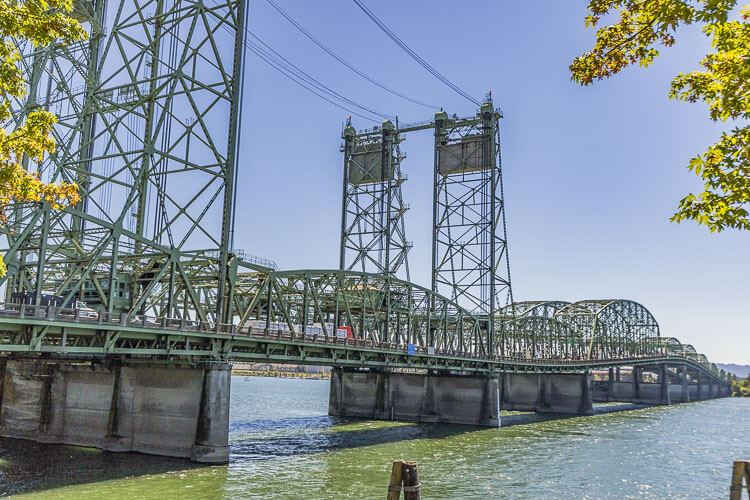
Administrator Greg Johnson responds to Clark County Today’s numerous questions about the proposed bridge replacement
Ken Vance, editor
Clark County Today
Despite recent resistance to the Oregon Department of Transportation’s (ODOT) tolling proposal, Interstate Bridge Replacement Program Administrator Greg Johnson confirmed that tolling is a “necessary’’ part of the funding required to build and operate the I-5 Bridge replacement project.
In a recent exchange with Clark County Today, Johnson confirmed that the soonest tolling could begin on the I-5 Bridge project would be 2026. But, he insisted it was necessary.

“Tolling is a necessary part of the 3-legged stool of funding required to build and operate the Interstate Bridge Replacement program,’’ Johnson wrote in an email response to Clark County Today. “Tolling for the IBR program is anticipated to include variable priced tolling, with the goal of funding construction and facility operations and maintenance, improving reliability and managing demand, encouraging the use of other modes of travel and off-peak travel, and reducing optional trips. All of this would help improve mobility through the Interstate 5 corridor. The IBR program is only considering tolling of the I-5 bridge and is not looking at implementing tolling on I-205.’’
In April, the Clark County Council adopted a resolution in opposition to tolling on the I-5 Bridge and the I-5 and I-205 corridors in the Portland Metropolitan area due to the “unreasonable burden’’ the tolls would place on Clark County residents, an estimated 75,000 of which commute to work in Oregon.
Also in April, the Washington State House of Representatives passed Senate Bill 5765, which would open the door for tolling on the Interstate 5 Bridge replacement project between Vancouver and Portland. The bill would allow for tolls to be set by mutual agreement between the two state Transportation Commissions, and a toll account would be created for toll revenues. The bill was passed in spite of the objections of Southwest Washington Republican lawmakers Greg Cheney, Stephanie McClintock, Paul Harris, Kevin Waters, Ed Orcutt, Peter Abbarno, all of whom voted against the bill.
After months of advocacy, legislative Democrats representing the Clackamas County area in Oregon scored a major victory this week for regional communities facing the impacts of tolling on I-205. In a letter Tuesday (May 2), the Speaker of the House, the Senate President, and the Co-Chairs of the Joint Transportation Committee announced the creation of a Special Subcommittee on Transportation Planning to oversee and monitor ODOT’s plans to mitigate the negative impacts of tolling on vulnerable communities. In order to make sure that any tolling program is carefully considered and incorporates the feedback from impacted communities, Oregon Governor Tina Kotek is responding to the calls of the legislators and pausing all toll collections until January 2026.
As far as potential toll rates, Johnson confirmed the toll rate setting authority lies with the Washington and Oregon Transportation Commissions.
“Following initial analysis, the IBR program currently assumes that $1.24 billion would come from toll funding,’’ Johnson said. “Work to inform the financial plan included toll scenarios for study ranging from $1.50 to $3.55 in year of toll start, depending on time of day. The toll scenarios in this analysis are used for study purposes only to inform financial planning, and do not represent final rates.’’
Johnson added that “a low-income toll program will be considered in additional toll scenario analysis, with input from the Transportation Commissions. The commissions’ adoption of toll rates is not anticipated to occur until shortly before tolling is estimated to begin on the facility. The soonest tolling would begin on the facility is in 2026.’’
Cost estimate
Johnson also explained how he believes tolling fits into the total cost estimate of the I-5 Bridge replacement project.
“The IBR program’s current cost estimate ranges from $5-$7.5 billion, with a likely cost of $6 billion,’’ he said. “This estimate includes the costs associated with the regionally endorsed program investments for a fixed-span bridge and accounts for current market conditions, along with potential risks and opportunities.
“This cost estimate can be broken down into four high-level categories: the Interstate Bridge replacement and approaches, investments in Washington, investments in Oregon, and transit investments,’’ Johnson added. “A more specific breakdown for each individual element of the program is not currently available, but work will continue to refine these cost estimates as additional detail is determined.
“The estimated cost of a replacement bridge and approaches ranges from $1.64 to $2.45 billion, depending on the final design and configuration,’’ he said. “This includes the cost of the multimodal bridge across the river, the approaches needed to connect to the new bridge and removal of the existing bridge.’’
Johnson also added the estimated costs on both sides of the Columbia River.
“The estimated cost of investments in active transportation, roadway and interchanges in Washington ranges from $.99 to $1.49 billion,’’ he said. “This cost estimate includes investments to the interchanges at SR 14/C Street, Mill Plain Boulevard, Fourth Plain Boulevard, and SR 500, as well as a community connector.
“The estimated cost of investments in active transportation, roadway and interchanges in Oregon ranges from $1.05 to $1.57 billion,’’ Johnson said. “This cost estimate includes replacement of the North Portland Harbor Bridge, investments in the Marine Drive and Hayden Island interchanges, as well as an arterial bridge for local traffic between Marine Drive and Hayden Island.’’
The remaining funding consists of the transit component of the project. On April 21, 2022, the IBR team announced that light rail would be the locally preferred alternative as a transit option for the new bridge. The IBR team is proposing a light rail extension along I-5 to Evergreen Blvd. The belief is a light rail stop at Evergreen Blvd. near the Vancouver library is the best location to connect C-TRAN with TriMet.
“The transit component of the program is estimated to cost $1.32 billion to $1.99 billion,’’ Johnson said. “This includes the cost of guideway and vehicles for light rail transit, buses and bus on shoulder, constructing three new transit stations, up to two park and ride locations in downtown Vancouver, and facilities to operate and maintain transit. Decisions about the number of potential park and rides, location, sizes, and other details will be made after the Draft SEIS is released.’’
Potential funding sources
In addition to the tolling revenue Johnson believes is “necessary’’ for the project, the IBR administrator outlined the other funding sources.
“The IBR financial plan identifies potential funding sources and financing mechanisms, including federal funds, tolling, and state contributions, which are needed to achieve the most likely cost estimate of $6 billion,’’ he said. “In addition to a $1 billion contribution from each state, the funding estimate identifies $1.24 billion from tolls, and $2.5 billion from federal competitive grants.
“The IBR program is committed to maximizing federal grant funding and plans to apply for the U.S. Department of Transportation Mega Grant (National Infrastructure Project Assistance Program) and the Federal Highway Administration Bridge Investment Program grants this year, once grant requirements are released. The program also expects to apply to start the multistep application process for the Federal Transit Administration Capital Investment Grant process in summer of 2023, which is estimated to fund approximately $1 billion of transit investments, in addition to other eligible funding sources identified as part of the financial plan.’’
Who will pay for operations and maintenance of the light rail?

If light rail is going to be a component of an Interstate Bridge replacement project, C-TRAN Chief Executive Officer Shawn Donaghy has been clear in the past that the agency he leads is not going to be responsible to operate it or be financially responsible for it. Donaghy said at the time the light rail component of the project was announced that it presented the best opportunity to connect C-TRAN with TriMet. He believes the “running I-5” scenario was best, rather than going on downtown Vancouver streets. However, what C-TRAN’s CEO didn’t say at that time was that the light rail element of the project needs to be managed and operated by TriMet, not C-TRAN, or even a combination of the two agencies. That question has yet to be answered.
“The Draft SEIS will include initial estimates for yearly transit Operations & Maintenance (O&M) for the program,’’ Johnson said. “Currently, the IBR program is working with both TriMet and C-TRAN to develop the O&M finance plan for transit, to define who will be responsible for operating or maintaining each transit element, and to explore all potential new and existing sources of funds and the administration of expenditures.
“The funding assumptions in the financial plan will continue to evolve as the IBR program cost estimates are updated as the program moves further into design, and more information is known about anticipated and prospective funding,’’ Johnson said.
Many Clark County residents have resisted the IBR’s inclusion of MAX light rail in its LPA. Using Johnson’s own numbers, the total cost of the project could be reduced by up to $1.99 billion by eliminating the MAX light rail, which also includes “new revenues” TriMet is demanding from residents on both sides of the Columbia River, to cover the operations and maintenance costs of a 3-mile light rail extension.
Modified LPA & Draft SEIS
Many elected officials have complained that important details pertaining to so many elements of the I-5 Bridge replacement project have yet to be revealed. Johnson stated that those details would continue to be provided.
“The Modified Locally Preferred Alternative (LPA) identified high-level components that are being analyzed in the environmental review process,’’ Johnson said. “The impacts and benefits associated with the Modified LPA will be disclosed in the Draft Supplemental Environmental Impact Statement (SEIS) that is expected to be published later this year.
“To best understand the range of potential impacts and benefits, the program is studying options of certain elements within the Modified LPA, such as bridge configuration and auxiliary lanes,’’ Johnson said. “While all bridge configuration options being studied assume two side-by-side structures, the program is analyzing double deck/stacked, single level, and movable span configurations.
“The analysis of various options including the design details studied will be released as part of the Draft SEIS,’’ Johnson said. “Studying these options will minimize potential delays if impacts or performance issues of the Modified LPA are discovered in the SEIS analysis process.”
U.S. Coast Guard height requirement
In March, Johnson told Clark County Today that the IBR team had added a movable span to its study of design options for an I-5 Bridge replacement. However, Johnson said he believes external stakeholders want the project to move forward with a fixed span design.
After the IBR team initially proposed a 116-foot height for a new bridge design, U.S. Coast Guard officials revealed in June of last year (2022) that any replacement of the existing I-5 Bridge needs to have a vertical navigation clearance (VNC) of at least 178 feet. The existing I-5 Bridge has a lift span to accommodate the need for the taller vessels.
“In our commitment to partners to mitigate risks to our budget and timeline for construction, the Interstate Bridge Replacement (IBR) program in coordination with our federal partners, Federal Highways Administration (FHWA) and Federal Transit Administration (FTA), has included a movable span in our study of design options,’’ Johnson told Clark County Today in March.
“In February (2023) the Coast Guard delivered a letter to FHWA and FTA requesting that the program also study a design option that provides 178 feet of river clearance,’’ Johnson added. “To do this the program is moving forward with studying a movable span as part of the National Environmental Protection Act (NEPA) review process. Studying the movable span as a design option now serves as a risk mitigation strategy to minimize schedule delays and will allow the community and partners to provide public input through the official environmental review process in late 2023.’’
Also read:
- Rep. John Ley issues statement after I-5 Bridge replacement meeting yields few answersRep. John Ley criticized the IBR Program for failing to provide updated cost estimates or key design decisions following a recent legislative oversight committee meeting.
- Opinion: Too deep to drive – flooded roadsDoug Dahl explains why even shallow water on roadways can be dangerous for drivers and outlines the risks of hydroplaning and driving through floodwaters.
- C-TRAN takes no action on Board Composition Review Committee’s directiveAfter a long executive session, the C‑TRAN board took no action on a 4‑3‑2 board composition proposal that has divided Vancouver, Clark County and the small cities.
- Opinion: Sound Transit – No cause for celebrationCharles Prestrud argues Sound Transit’s costly light rail expansions have failed to boost overall ridership or ease Puget Sound congestion.
- Opinion: Simultaneous left turnsDoug Dahl explains how Washington law directs drivers to make simultaneous left turns by passing to the left of each other in an intersection.










Tolling is not “necessary”. The IBR team allege they “need” the tolls to pay back $1.25 billion of borrowed money.
If they simply built a cheaper IBR, they would have no need to borrow money. In fact if they eliminated the MAX light rail component, they could save nearly $2 billion! No borrowing necessary!
Per an article by the Cascade Policy center in May, 2022,
“Earlier this month, the Oregon Transportation Commission circulated a memo with an update on the Interstate Bridge Replacement Program (IBR). That memo declared, “Tolling would begin in late 2025 to early 2026.” In a slideshow to the commission, one of the slides projected, “I-205 tolling launches by the end of 2024.”
This is the link for the Cascade Policy Center article.
https://www.clarkcountytoday.com/opinion/opinion-plans-are-in-place-to-force-oregonians-to-pay-for-the-privilege-of-waiting-in-traffic/
Since none of this light rail garbage project is needed or wanted, then, in fact, tolls are NOT “necessary” (OR wanted by the people having it rammed down our throats)
And, have you all noticed that none of those screaming the loudest to get this horrific waste of money built will have to pay the $2000 a year in tolls (Just to start, with increases looming on the horizon) on this side of the river, only to have to pay additional tolls on the OTHER side of the river will have to pay those tolls?
Not that clowns like Johnson care about blowing a $100 million dollar or more hole in Clark County’s local economy… as long as HE and his buddies get paid.
When you want to find the definition of unresponsive government and corruption, just look this guy and the other leftist cheerleaders up. You’ll see all you need to know.
Two problems. First, the crossing should be a tunnel to mitigate the height issues. Second, tolls should end once the construction costs are paid off. O & M costs should come from highway funds like any other road.
A Columbia River Crossing in my life time? That will never happen the same team as last time…
Of course they will go ahead and do it ! They never cared one bit of anyones input! They just want you to THINK you had a say!